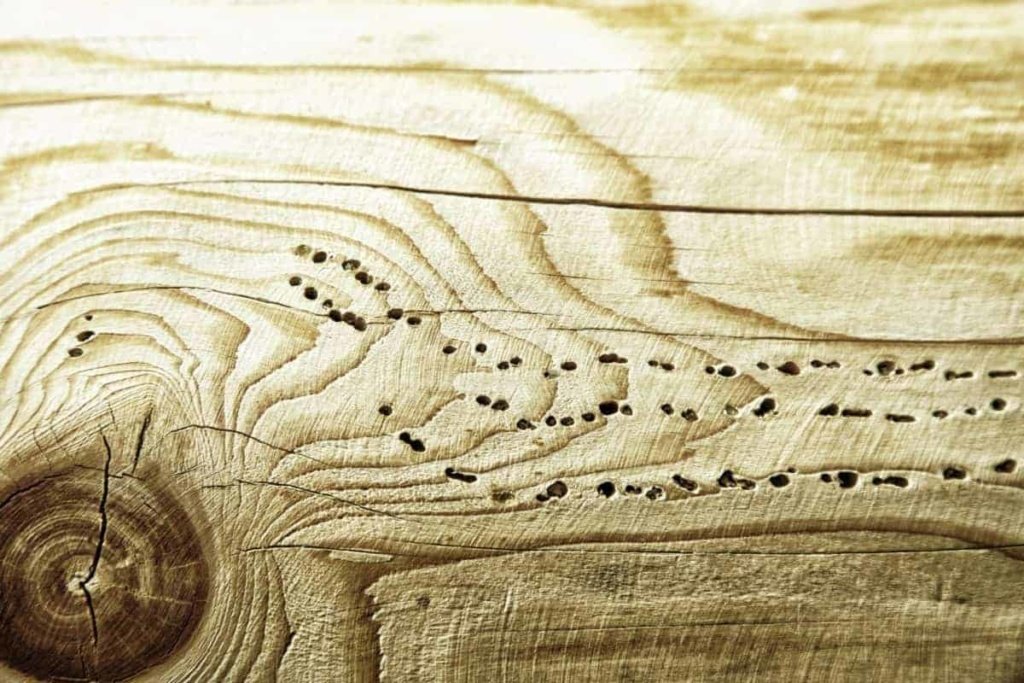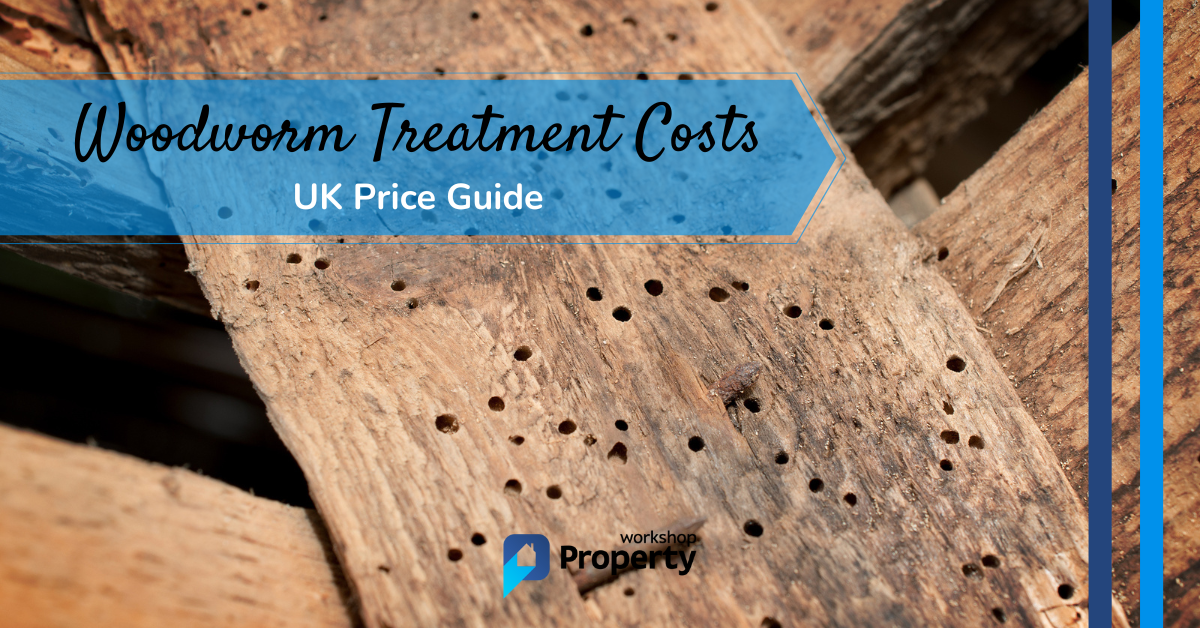Woodworm infestations are a common problem throughout the UK. These hungry little creatures eat their way through your furniture and timber, leaving destruction wherever they go.
If you’re worried about woodworm, you probably have many questions. How do I know if I have woodworm? How much does woodworm treatment cost? Can I do it myself, or will I need to hire a professional?
Don’t panic. Here at Property Workshop, we understand the stress caused by woodworm and the potential expense of getting rid of these uninvited guests. That’s why we’ve created this in-depth guide to help you find the answers to your questions.
So, what are you waiting for? Read on to learn all you need to know about the costs and implications of woodworm treatment.
In a Hurry? Find top-rated woodworm specialists in your area by clicking the button below:
What is Woodworm?

The larvae of wood-boring beetles are known as ‘woodworm’. A woodworm infestation begins when a female wood-boring beetle lays eggs inside your timber’s cracks, holes and crevices.
After a few weeks, her eggs hatch and the larvae begin to feed on the material around them — eating their way through the wood and potentially causing serious structural damage. They’ll continue to do this for between 2 and 5 years before developing into adult beetles and burrowing out of the timber to breed.
There are 3 common species of woodworm beetles found in the UK. All follow the same general life cycle, but their habits, preferred timber and damage level differ. For this reason, it’s crucial to correctly identify the type of woodworm present in your home before treatment.
Let’s take a look at the three most common species of woodworm beetles in the UK:
1. Common Furniture Beetle
The common furniture beetle is the most widespread wood-boring beetle in the UK. It’s greenish-brown, around 3 to 4.5mm long and ‘beetle-shaped’.
Preferring the sapwood of both hard and softwoods, woodworm often burrows with the grain and is capable of causing significant damage if left unchecked. Their droppings (or ‘frass’) look like small oblong pellets with a coarse texture similar to sand.
When they exit the wood as adults, they will bore 2mm wide holes in the surface, which should be visible.
2. Death Watch Beetle
Usually found in central and southern regions of the UK, the Death Watch Beetle has a velvety appearance and is mottled light and dark brown.
Around 7mm in length, this beetle is attracted to damp, rotting hardwoods. It prefers timber in very bad condition, so it isn’t often found in well-maintained properties.
Like the Common Furniture Beetle, Death Watch Beetles create exit boreholes around 2mm in width; however, their woodworm tunnels are filled with frass, which will be easily visible once the wood is broken open.
This beetle headbutts the wood during the late spring and early summer months to attract potential mates. Therefore, if you hear an unsettling tapping sound emanating from the walls, you likely have a Death Watch Beetle infestation.
3. House Longhorn Beetle
You can find the House Longhorn Beetle throughout the UK, but it’s most common in Berkshire and Surrey. They’re large at around 10–20mm long, dark brown and have distinctive long antennae.
These pests prefer softwoods and create deep tunnels, which result in significant structural weaknesses. As they’re so large, they commonly break through the surface of the wood when tunnelling and create 10mm wide exit holes. Thus leaving obvious damage to your timber and furniture.
Unfortunately, House Longhorn Beetle infestations are the most serious. If you think you have this species on your property, you should seek professional assistance to eradicate them.
Woodworm Treatment Options — DIY or Hire a Pro?
If your woodworm problem is confined to a table or an antique you’ve bought at a car boot sale, it’s possible that you could deal with this yourself. However, you must be sure you have correctly identified the type of species that you’re dealing with first.
On the other hand, if you’re suffering from a woodworm infestation that has spread throughout large areas of your home and might be compromising structural timbers — professional help is the way to go. House Longhorn beetles, in particular, can cause serious damage to your property if they’re not treated correctly.
If you’re unsure how bad the infestation is or which type of woodworm has invaded your home — you should invest in a professional survey to find out.
DIY Woodworm Treatments
Below are details of the two main treatment options — Permethrin and Boron.
Permethrin
This insecticide attacks the nervous system of the beetle and larvae, killing them quickly. Applied to the surface of the wood with a brush or a spray gun, the chemical seeps into around 5mm deep, effectively targeting larvae and adult beetles which come into contact with it.
Permethrin surface treatment works well with the Common Furniture Beetle. Still, it’s less effective for Deathwatch beetles because these beetles burrow deeper into the timber than a surface application can reach.
The best way to combat Deathwatch infestations with permethrin is to inject a gel solution into the timber. Although it’s possible to do this by injecting the gel into existing exit holes, drilling new holes often yields better results.
There’s no doubt that permethrin is a very efficient insecticide that kills all crawling insects. However, the downside of this efficiency is that it’s highly toxic. If you choose this method, you should wear a mask, eye goggles and gloves during the application process and vacate the area for a couple of hours afterwards.
Warning! Due to its toxicity, permethrin should be avoided if you have kids or pets.
Boron
Boron is a chemical found in many insecticides. Once ingested, it acts as a ‘stomach poison’, rapidly killing any insects which consume it. However, unlike permethrin, Boron has a much lower toxicity level, which makes it a safer treatment option for households with children or pets.
Boron is available as a pre-mixed gel, liquid or powder formula. It can be applied to affected wood with a spray gun, an applicator gun or a brush. Surface treatments are effective for Common Furniture Beetles, but Deathwatch Beetles will require a gel solution to be injected into the wood.
Even though boron is less toxic than permethrin, using protective gloves and a mask is recommended. Once applied, you can re-enter the room in as little as an hour.
Professional Woodworm Treatments
Professional bug killers use specialized equipment to apply insecticides over much larger areas. They may use industrial-sized sprayers to apply insecticides or foggers and fumigation to eradicate these unwanted pests.
Fogging involves the release of an insecticidal fog beneath floorboards to target woodworm which has penetrated this area. Usually, this type of treatment doesn’t require much downtime, and you should be able to re-enter the room after a couple of hours.
On the other hand, fumigation requires the extensive use of chemicals to permeate all areas of the property. Whilst very effective, this method often uses toxic gases, and you will have to vacate your home for a few days afterwards.
Check out this video to learn more about the fumigation process.
Woodworm Treatment Cost in 2024
Below are the woodworm treatment costs you can expect to pay in 2024. Note that prices will vary depending on your location.
DIY Woodworm Treatment
Home-based DIY permethrin and boron treatments such as sprays, gels and liquids can be easily purchased from hardware stores or online. Prices range from £7–£35.
Protective gloves, masks, and brushes can all be picked up for around £10–£15 each. Many woodworm treatments will come complete with applicators. But if you need to purchase them separately, applicator guns and sprayers can be picked up for around £25–£50.
Overall, the total cost for DIY treatments is generally between £50–£130.
Professional Woodworm Treatment
You should expect to pay between £500–£1,000 for professional help to eliminate woodworm from your property.
Naturally, the price varies widely depending on the extent of the infestation, the type/number of treatments required and the size of your home. A professional survey can tell you the extent of the damage you’re dealing with — this usually costs between £80–£200.
Whilst simple DIY treatments may only take a few hours, professional treatments for serious infestations can take 1–3 days to complete.
Smaller, local pest-control companies are generally more affordable than well-known services such as Rentokil.
If you need professional help, we recommend checking out Rated People to find highly-rated woodworm services in your local area.
Woodworm Treatment — 2024 Cost Comparison Table
| Job Type/Size | Average Costs | Time |
|---|---|---|
| Woodworm Survey | £80–£200 | 1–4 hours |
| DIY Permethrin/ Boron | £50–£130 | 1–2 hours |
| Professional | £500–£1,000 | 1–3 days |
Don’t fancy doing this job yourself? Find top-rated woodworm specialists in your area by clicking the button below:
Final Thoughts
As we have seen, the cost of woodworm treatment heavily depends on the type of woodworm beetle on your property and the extent of the infestation.
In some cases, minor woodworm infestations in furniture can be treated yourself using insecticide solutions. However, if the issue is more widespread, affects structural timbers or involves the dreaded House Longhorn Beetle — professional help will be required to get the situation under control.
Dealing with woodworm is stressful enough as it is, without the hassle of finding the best control service to deal with the problem. So, if you need professional help, check out Rated People to find highly-rated services near you.

